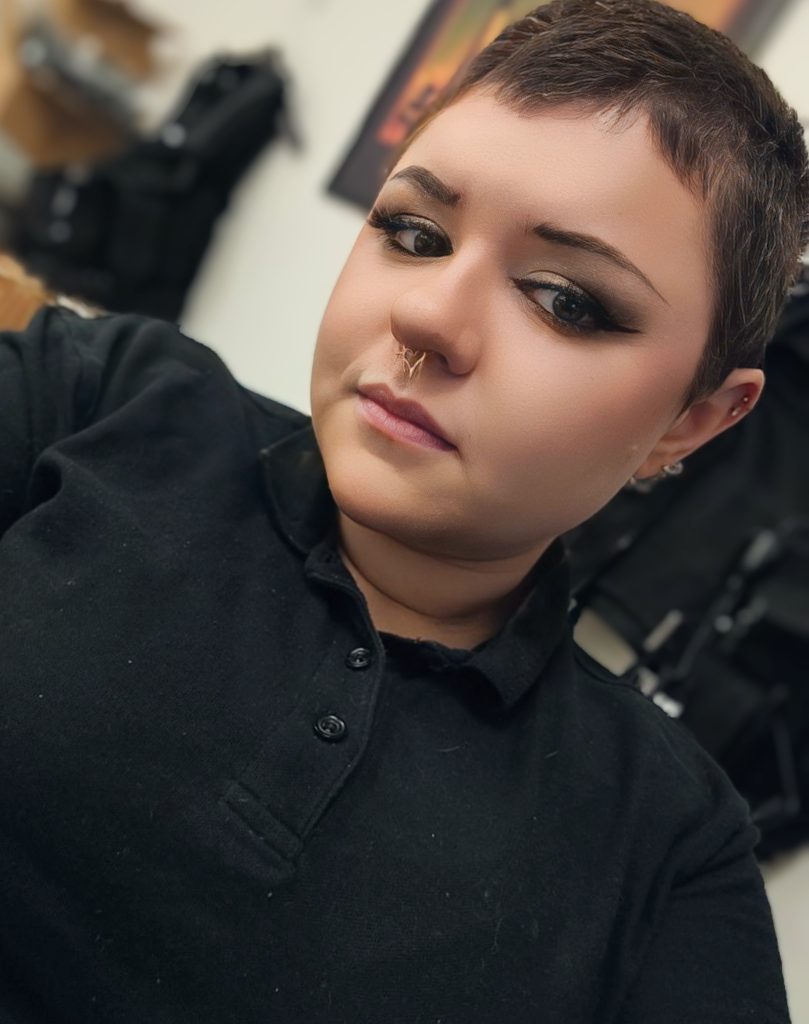I never let myself be clingy, or messy, or too much of anything. Bright, colorful kids got attention—I made sure I didn’t. I was the smart one, the well-behaved one, almost invisible—like a mini adult trapped in a child’s body. The goody two-shoes who never skipped school, who signed up for college classes in high school, who never experimented or tested boundaries. And for a long time, I thought that made me better, ‘Superior’ even, because I wasn’t like the other kids.
But really, I was surviving an abusive home. I learned early that being invisible was safer. That if I was quiet, perfect, and small, I might avoid the worst of it. What I didn’t realize back then was that what I lost was the right to live. The right to live wrong, or live right. The right to make mistakes, to be messy, to figure out what freedom actually feels like. The right to want something just because I wanted it, not because trauma was making the choice for me.
Military Trauma and the Fog After
My first suicidal urge was before I even turned sixteen. That detail matters because it shows I was still a child, carrying all that weight while living in conditions no child should have to grow up in. Growing up in an abusive home, I thought military service was my only way out—my only chance to obtain an education, a proper job, and a way out in general.
The military didn’t make things easier. I went in as a high-performing airman, someone who could get things done under pressure. But the regular stress of duty mixed with military sexual trauma pushed me further into dissociation. I didn’t come home with visible injuries, but I came home completely detached from myself.
Maladaptive daydreaming became the way I coped with all of it. For people who don’t know, maladaptive daydreaming isn’t just zoning out with a fantasy once in a while—it’s getting so wrapped up in vivid, detailed daydreams that it becomes your main escape. Whole hours disappear. Real life takes a back seat while your brain runs movies it would rather live in. It feels safer than being in your body, but it pulls you further away from reality.
That’s why people fall into it: it’s a softer place to exist when reality feels unbearable. But the trade-off is that it causes you to regress. You stop building your actual life, because the daydreams feel easier to control. And once you start relying on that, it’s incredibly hard to stop.
At my lowest, the only work I could handle was something with almost no complexity, like being a store greeter. And even that was too much. I’d get overwhelmed just trying to say “Good morning” to a stranger. I went from a high-performing airman to barely managing the bare minimum to keep myself alive.
Understanding Dissociation
Everyone dissociates sometimes. You know when you’re driving and suddenly realize you don’t remember the last five minutes of the road? Or when you’re so deep in a game or a show that someone has to call your name three times before you hear them? That’s normal dissociation—everyday zoning out.
For me, it wasn’t Netflix zoning out. It was leaving my body when I felt unsafe. It was losing hours because my brain decided I wasn’t safe enough to be there. And here’s something worth saying: not all dissociation is DID. PTSD has it. Depression has it. Even OCD can have it.
For me it showed up as depersonalization—feeling like I was outside my own body, watching myself move around but not really there. Or derealization—where the world felt fake, like I was walking through a movie set. At first, I didn’t even realize that was abnormal. I thought life was just foggy and unreal.
And that’s the tricky part: some people don’t recognize when they’re dissociating. I didn’t. I just thought I was really bad at being a person—too forgetful, too spacey, too detached. I didn’t know it had a name, or that it came from trauma.
It wasn’t until I smoked weed for the first time that I realized: it didn’t have to be that way. The world wasn’t supposed to look like a dream sequence. I wasn’t supposed to feel like a ghost floating outside myself. Weed cut through the haze and showed me what presence actually felt like.
The way memories work in those dissociated states is just as strange. They’re patchy, dream-like. Sometimes just flashes without context. Sometimes it’s like watching a movie of myself instead of recalling my own life. Weed was the first thing that brought memories back with feelings attached—grounded in my body instead of hollow pictures.

Stacked Diagnoses and Meds That Never Helped
By the time Dissociative Identity Disorder (DID) was even mentioned, I’d already been stamped with a pile of other labels. For anyone who doesn’t know, DID is what used to be called “multiple personality disorder.” The name was changed in the 1990s to better reflect that it’s not about having “multiple people,” but about one person whose identity has fragmented in response to trauma. Still, most of the modern world recognizes it under the old name, which can feel inaccurate or even offensive to people who live with it.
DID usually develops from repeated trauma in early childhood, especially before the age of nine, when a child’s sense of self is still forming. To survive what feels unbearable, the mind walls off different experiences, creating distinct parts—each carrying their own memories, emotions, roles, and even needs, such as sleep, hunger, or thirst. Some individuals with DID can confuse needs, wants, and other signals because of that lack of awareness of themselves.
Here’s the thing: DID isn’t rare. It’s estimated to affect about 1-3% of the population. That’s about as common as serving in the military, as being transgender, and as having schizophrenia. The problem isn’t that it’s rare—it’s that it’s deeply misunderstood. Because of that, most doctors will try every other diagnosis before even considering it.
I had already been labeled with Complex PTSD, Adjustment Disorder, Nonverbal Learning Disorder (NVLD), maladaptive daydreaming, OCD, and Major Depression. Some of them fit, some didn’t, but none explained the whole picture. That’s the reality of being in the medical system with a dissociative disorder: doctors will try everything else first.
With those labels came the meds. I’ve been cycled through pretty much every SSRI on the market, combinations of SNRIs and dopamine-based ones. At one point, a doctor even tried Adderall. None of it touched the dissociation. If anything, it left me walking around in someone else’s skin, unable to act on my own wants. I couldn’t actually live.
That’s where harm reduction comes in. When you’re dealing with severe mental illness, the choice isn’t always between “perfect health” and “nothing at all.” Sometimes it’s between nothing at all and something that helps you survive. For me, cannabis became that something.
Free Weed, Still Bitter
And then there were the alters themselves. Whatever part was fronting decided my emotions. Sometimes it was the persecutor—the bitter one who never let me enjoy anything. Living as him was like being stuck with that friend at the smoke circle who complains about everything, sighs too loud, rolls their eyes when everyone else is laughing. And the wild part? He didn’t even bring the weed. Free weed, and still mad. Who can be bitter with free weed?
That’s what persecutors do. They aren’t “evil alters.” Their job is to keep a person who experiences plurality on edge, to punish before someone else can, to make sure we never forget the danger. It feels insufferable when they’re fronting—like my whole personality collapses into pure resentment. Almost like pattern recognition on an emotional level: he scans for every possible thing that could go wrong, and then makes me live inside that bitterness.
And the punishment can look small from the outside—like refusing to try because the fear of embarrassment is too strong—but inside it’s huge. Other times, persecutors will take it further: pushing the body into behaviors that are damaging or risky. That’s one of the hardest parts, because it doesn’t just affect the persecutor, it causes distress for the whole collective. Almost every person who experiences plurality and has persecutors knows this battle: you’re not just fighting the trauma, you’re fighting the coping mechanisms that trauma built.
Therapy That Finally Worked
Weed grounded me. And for once, all those clichés people throw around—“how to better yourself,” “how to succeed at therapy”—actually started to click. It was overwhelming at times, emotionally overstimulating to the point of regression, but that was growth.
Weed made everyday tasks—the ones I’d normally dissociate through—feel like fun little challenges. Grocery shopping, eating at restaurants alone, even going to the gym became things I could enjoy. I even picked up gardening so I could grow my own plants, and learned about terpenes—the aromatic compounds in cannabis that shape flavor, scent, and effect.
Lemon Haze really does smell citrusy because of limonene, which boosts mood and energy. Miracle Alien Cookies has that earthy, peppery kick from caryophyllene, linked with calming stress and inflammation. Georgia Peach has a floral sweetness thanks to linalool, the same terpene in lavender. Once I learned how these worked, I could choose strains that matched what each part of me needed.
Pink Pineapple for the gym. Miracle Alien Cookies for schoolwork. Lemon Haze for cleaning. Georgia Peach for self-care like showering. And vaping made it easier to dial in the intensity—one pull to take the edge off, a few more to really settle in.
It wasn’t about perfection. It was harm reduction. For me, better than being dead. Cannabis calms the persecutor, lets me care for the inner child, and helps me grow in ways prescriptions alone never managed.
Dissociative Identity Disorder & Cannabis
For the first time, I finally got to explore each part of me, to see how they work and what they need. Because together, we make the person named Peri’lias De Brise.
But here’s the question I’m still sitting with: do we even know who that person really is?
What I do know is this: DID isn’t rare—it’s just hidden. As mentioned before… it’s about as common as being in the military, as being transgender, or as having schizophrenia. And for me, weed was the thing that finally made it visible enough to start healing.
About the Author
Peri’lias De Brise is a disabled veteran and writer, sharing his journey of trauma and healing alongside his service dog, Nes.


